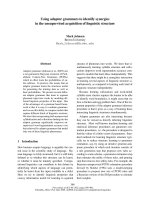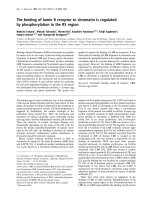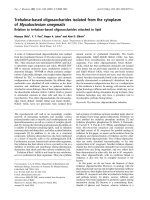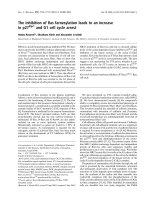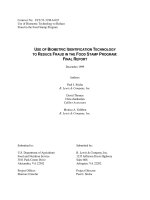the research of using epad technology to support activities in administrative system
Bạn đang xem bản rút gọn của tài liệu. Xem và tải ngay bản đầy đủ của tài liệu tại đây (1.44 MB, 124 trang )
1
1
VIETNAM NATIONAL UNIVERSITY, HANOI
COLLEGE OF TECHNOLOGY
Nguyen Hoai Nam
THE RESEARCH OF USING EPAD TECHNOLOGY
TO SUPPORT ACTIVITIES IN ADMINISTRATIVE
SYSTEM
GRADUATION THESIS
Major Field: Information Technology
HA NOI - 2009
2
3
4
5
VIETNAM NATIONAL UNIVERSITY, HANOI
COLLEGE OF TECHNOLOGY
Nguyen Hoai Nam
THE RESEARCH OF USING EPAD TECHNOLOGY
TO SUPPORT ACTIVITIES IN ADMINISTRATIVE
SYSTEM
GRADUATION THESIS
Major Field: Information Technology
Supervisor: Dao Kien Quoc, MSc
HA NOI – 2009
SUMMARY
Administrative activities contain many problems that need to be solved in some
aspect of time schedule, responsibility and productivity. The fact that building software to
control all problems above is better, but some software could not be used when published.
In this thesis, together we will approach the problems and find why some software are
failed in real life.
In this thesis, we found a new idea for the problem of administrative formality
software. Based on this solution, we analyzed the administrative system, built design
document.
To prove the idea, from the design document, we built the solution software to
illustrate how the idea worked and prove it could help increase the software’s effect and
feasibility.
1
ACKNOWLEDGEMENT
First of all, I wish to express my respect and my special thank to my adviser MSc.
Dao Kien Quoc, College of Technology, Vietnam National University, Hanoi for the
enthusiastic guidance, warm encouragement and useful research experiences.
I would like to gratefully thank all the teachers of College of Technology, VNU for
their invaluable knowledge which they gave to me during four academic years.
Last, but not least, my family is really the biggest motivation behind me. My parents
and my brother always encourage my when I have stress and difficulties. I would like to
send them my gratefulness and love.
Hanoi, May 2009
Nguyen Hoai Nam
2
TABLE OF CONTENTS
SUMMARY 1
ACKNOWLEDGEMENT 2
TABLE OF CONTENTS 3
Chapter 1: Introduction 4
1.1. Introduction to administrative formalities 4
1.2. Necessary of administrative activity and document processing software 4
1.3. Determine why some software failed to be used when published 5
1.4. Solution 6
Chapter 2: Requirement and Specification 8
2.1. Problem analysis: 8
2.2. Requirement and solution 10
Chapter 3: Design 13
3.1. Purpose 13
3.2. System functions 13
3.3. Determine actors, use case in use case diagram 15
3.4. Use case diagrams and description 21
79
3.5. Sequence diagrams 79
3.6. Operation contract 84
3.7. Class diagram 99
Chapter 4: Specific solution of using ePad signature and verification 101
4.1. Overall solution approach 101
4.2. An introduction to ePad device and signature verification issue 102
4.3. Demo solution 107
Chapter 5: Conclusion 117
APPENDIX 118
Table of figures 118
REFFERENCE MATERIAL 119
3
Chapter 1: Introduction
1.1. Introduction to administrative formalities
The purpose of administrative activities in an organization is to make decisions
precisely to keep all parts of organization work in a harmony.
Administrative activities could be able to divide into following types:
• Internal activities which involved in individual or sub-ordinates:
o Incoming document processing (register to incoming book, decide
destination, give comments …)
o Document publishing (approve document, edit document …)
o Task processing ( task requested by the manager)
o Collect documents (collect a group of document to support manager to do
administrative activities, but not create or wait for approve)
• Activities depends on external factors:
o Undetermined tasks occur when new incoming documents come or
documents have to be sent out.
As usual, activities depends on external factors contain a part of internal activities.
All information and decisions are represent in document. In general, both two types
of administrative activities involve in document processing, which divided into two types:
• Incoming document: from outside, via many methods: email, post office, fax …
• Outgoing document: published inside organization or sent out.
1.2. Necessary of administrative activity and document processing
software
There are many reasons for a low-productive administration system:
• Lack of information or problem of finding information due to late coming
document or a large number of documents so that people could not find.
• Members’ time schedules are not synchronized: it is hard to optimize the time
process of all people or could not arrange to meet people to communicate.
• Lack of individual task control method: some officers who could not finish the task
tell that they have not known the request. Maybe the document is lost during
4
deliver process or they tell lies to conceal their mistakes. The only solution for this
problem is having a way to control how officers do the task.
• The managers will find it is difficult to know the process of whole tasks unless
they meet each individual to ask. If they could not have time to arrange a meeting
between each individual, they have to wait for the responses from subordinates.
The fact that waiting for subordinates is wasting time and not effective.
Therefore, we need a software that solves all problems above, which:
• Use centralization model and online processing: all documents related could be
store on server (only entity for each document), then users could access documents
everywhere. Moreover, users could search for document without any difficulties.
• Tasks will be uploaded directly: saving time of all members. Users have to access
the Internet to view tasks. Result will be sent to server and could be viewed every
time and everywhere. That solution could increase the productivity.
• Distance will not be a problem anymore. User could view activities at any place.
• Individual’s responsibility will increase because all task and status of task
(finished, not completed …) is public. Moreover, log files to mark all states of
tasks will be the evidents to control subordinates.
• Task reminder is run automatically to remind so that users could not forget the
task.
• All documents will be verified by electric signatures to ensure the reliability and
individual’s responsibility.
1.3. Determine why some software failed to be used when published
Not only solving problems mentioned above, the software has to satisfy some factors
to become successful:
• The technology used: it decides the effect of the software including powerful, fast,
etc or the compatibility with other softwares or browsers.
• The cost of the software: the cheaper software is better.
• Graphic interface: the graphic interface decides the easy-to-use aspect of software.
5
However, many software which satisfy all factors above have failed in real life. One
reason that all softwares built for administrative activity purposes could not used in real
life is “users find it difficult to use them”.
Traditional method problem: Traditional method is a group of steps that officers
have been using for several years such as deliver the paper documents, sign the document
using pen … which almost involve in paper documents. At middle age, people tend to
prefer to work the same as they have worked for years so trying a new method like using
computer is hard for them. Moreover, at these age, people could not learn as fast as
younger ones. Therefore, they think it is better if they use traditional method again instead
of using computers.
As usual, all software when published require a period of time to train users, but most
users who use administrative formalities software are middle-age people who do not have
much experience in using computer, especially in Vietnam. They get troubles in some
issue:
• How to locate the document in computer when downloaded successfully.
• How to find a document in a folder full of downloaded documents.
• How to upload files to server.
• …
The reason is the steps they have to do with the software are much different from
steps they usually do in real life, which is considered as traditional method.
That is the reason why some software is published but never used.
1.4. Solution
Idea of automatic steps:
As mentioned in previous section, some steps that users may find difficulties in
downloading, opening and uploading files. My idea is the software has to automatically
do these steps for users: all steps that much different from traditional method should be
automatically executed.
6
The advantage of this idea is the users do not have to care about what is happening
under these steps, they simply do the steps which familiar to them. Therefore, it bring two
sequential advantages:
• Users may find using software is more convenient than using traditional method
including saving time deliver the document or waiting for responses, being able to
work at any place …
• Saving time and money to train users how to use the software: if it is nearly the
same with traditional method, users do not have to learn much.
The specific of this idea is mention in Chapter 4 Section 4.1.
Idea of using ePad device to sign and write comments:
ePad is a device which allow users to write directly to the document with its own
signature verification method. After opening the document automatically by software, the
manager does not has to write to a text area to sign or give comments, he simply sign as
he usually do with paper document.
The advantage of this idea is it is definitely the same as traditional method, which
works with paper document:
• The manager does not have to learn how to use text area, how to send signature …
he simply open the document and sign using pen attached with ePad device.
• The signature verification method of ePad helps users rely on the authentication of
the person who signed.
The more specific approach of ePad device is mention in Chapter 4 Section 4.2.
7
Chapter 2: Requirement and Specification
2.1. Problem analysis:
Document processing in administrative system is divided into four categories:
2.1.1. New incoming documents processing:
New incoming documents processing is divided to following steps:
• After receiving new incoming documents, administration department registers
this document into “incoming book”.
• New documents will be sent to the manager to check.
• New incoming documents will be stored by administration department.
• Publish of new incoming documents depends on the right level of staff
member, which decided by the manager.
• The destination of the documents after reviewing depends on the manager (the
manager will note on the document to which department the documents belong
to).
• The employees could see the document based on their own right level.
2.1.2. New outgoing document processing:
New outgoing document processing is divided into following steps:
• The officer or manager who desires to create new document will have to create
new document first.
• After being completed, the document will be transferred to collect comments
from other departments.
• After receiving comments, the author could edit the document before
forwarding to administration department.
• The administration department will check as if the document satisfied all
requirements:
8
o if the document missed some requirements, it will be turned back to the
author.
o if it pass all requirements, it will be sent to the manager.
• The manager who receives the document will approve the document .
• If the document is approved, it will be stored and registered into “outgoing
book” by the administration department.
• The document will be set the right of reading before publishing or distributing
by the manager.
• The destination written in the “outgoing book” will be the address of the
company or organization if the document has to be sent out, but the destination
could be noted as “internal publishing”.
2.1.3. Task processing:
Task processing includes following steps:
• When a chief or a manager need to assign tasks, he has to determine the
requests, due date and has to attach related documents if necessary.
• The chief or the manager also has to divide the task into steps with conditions,
order and due date for each step.
• Then he has to specify who is responsible for each step and who is responsible
for the whole steps.
• The subordinates who read the task could comment or provide solutions for the
task.
• An individual or group of people who is responsible for the task could attach
produced documents.
• The individual or the group will be reminded when the due date comes.
• The individual has to confirm the state of the request or the task.
• The individual could also request to get responses from the person who
requested or notice the following task of the request to another.
9
• He could attach produced documents if necessary with the request or task
provided.
2.1.4. Task schedule:
Each individual has to be provided a schedule which contains the tasks of a period
of time ( such as a week, a month, a quarter … ) with the due date and priority to work in
a harmony with other people.
2.2. Requirement and solution
2.2.1. Requirement
Document processing and administrative formalities involving occurs in every
company, organization … with years of traditional method. The purpose of a document
and administrative formalities system based on Internet is reduce all unnecessary steps
including steps which take much time like sending documents from department to
department or steps which are complicated like dividing tasks for a group of people.
Each company or organization has its own unique aspect in processing document
and administrative formalities, but all of them contain following issues:
• New incoming documents processing: new documents from other organization
include many tasks from registering into books to performing content of
documents.
• New outgoing documents processing: new outgoing documents in order to be
released are required to follow many steps: from checking draft documents to
sending to manager to publishing or sending out.
• Task processing: the requirement of tasks occurs based on documents is how the
manager could keep all tasks worked in a harmonic and finished earlier than
deadline. In addition, the manager has to find a way to control responsibilities of
subordinates.
• Task schedule: the fact that hundreds of task given every day suggests each
person have a schedule to remind next tasks and to arrange time logically.
The purpose of the system is to change all four issues of processing documents and
administrative formalities from traditional method to modern way based on Internet.
10
2.2.2. Solution
Four main functions need to be built:
New incoming document processing: The information “incoming book” will be
stored in database. Documents will be stored in server so that everyone could view the
documents (actually there is an only document for each incoming document stored in
server and everyone explores it) The manager could decide the destination of the
document directly instead of communicating with administration department. The
employee could connect to the Internet to view and download the documents if possible.
New outgoing document processing: Document created is stored in database and
could be viewed directly by specific person without taking time to print and to transfer to
specific department. The administration department could check it and send back through
Internet to author. The manager could set who could see the document. Information of
“outgoing book” is stored in database. The employee could view and download
documents when connecting to the Internet. Other organizations will receive documents
via email.
Task processing: The manager could create a task then divide it into sub-tasks. Each
task or sub-task could be inserted due date and who is responsible and status (finished, not
started, being done), edited and deleted. People could view their given tasks, give
comment and suggestion for the tasks. They could also send messages to others and get
responses about document’s issue. If due date comes, people could be reminded by
system. The manager could view all tasks status to control all processes and could remind
subordinates if necessary.
Task schedule: Each person has his own schedule to look up and could view due date
of all tasks.
When joining the company or organization, each person is provided an account to
login to system. With this account, a person could execute all functions above, but
function’s activities depends on type of user and right of user in each specific situation.
11
People’s feeling about the system in aspect of easy to use, productive or not depends
on how the activities of system relate to real life especially how they relate to traditional
method. With this idea, a successful system is the system requiring less time to learn, less
steps of mouse click or less fields to type. Therefore, the system need to reduce steps of
operation, moreover, some steps like viewing document, giving comments could be
automatic: the document should be automatically downloaded and open, the comments
should be attached directly to the document if necessary, etc.
12
Chapter 3: Design
3.1. Purpose
All document processing is completely automatic to support all stage of working
with documents from read new documents to create tasks base on documents or
requirement.
3.2. System functions
R.1. Login package
!
"#
R.2. Logout package
" !
""#
R.3. User management package
$%
$"&'
$$('
$)*
R.4. New incoming document processing package
)+,
)"
)$&
))*
))-
))".
R.5. New outgoing document processing package
13
/#0
/"%
/$(
/)
//1
/2&
/3
/4
/5
/6-
/6-
/6"+,
/6$
/6)7
/6/*
R.6. Task processing package
2%8
2"
2$#0
2)*
2)
2)"!
2)$
2))!9
2)/(9
2)2*9
14
2/!
22(
23*
24&
25&
251
25"&
25$&
26
2-:
2"%'
2$#0
R.7. View task schedule
3&
3"&
3.3. Determine actors, use case in use case diagram
3.3.1. Actors involve in the system:
- Manager
- Employee
- Administration department ( consider as an employee)
- Administrator
Actor Use case Results
Administrator All use case
Administration department Login Login to system
15
Logout Logout of system
Register to “incoming
book”
Store date, type of
documents and number
of documents
Store Store document into
database
Hide from web Set the document link
invisible on the web
Check document Check as if the document
satisfy all requirements
Send back Send the draft document
back to author
View View the document
Send to manager Send the document to
manager
Public Public document to all
employees
Register to “outgoing book” Register document
profile to “outgoing
book”
Send out Send the document via
Delete document Delete document from
database
View task View task assigned
Read reminded tasks Read the task reminded
Provide suggestion/solution Provide idea of new
solution or give
suggestion
Get response from others Get response from others
Confirm state of task Show the task status
( finish, pending
…)
Attach produced documents Attach additional
produced
documents
View schedule View schedule
Manager Login Login to system
Logout Logout of system
View documents Open and read the
documents
16
Decide destination Decide the destination of
the documents: public or
forward to subordinates
Approve documents Approve documents
Send back Send back to author
Set view right Set who can read the
document on the web
Create request Create new request or
task
Set due date ( for whole
task)
Set due date for the task
Attach documents Attach related
documents for the task
Divide tasks Divide task into steps or
stages
Set condition Set condition for each
step
Set priority Set priority or order for
steps
Set due date (for each step) Set due date for each
step
Set responsibility for each
step
Set who is responsible
for specific step
Set responsibility for whole
task
Set who is responsible
for all the steps
View schedule Read schedule task
View reminded task View reminded task
Employee View View documents
Create documents Create new outgoing
documents
Collect comments Get comments from
other departments or
another person
Send to administration
department
Send document to
administration
department to check
Edit document Edit document
Attach documents Attach documents
related
View task View task assigned
17
View due date View due date for each
task
Read reminded task Read reminded task
which is noticed when
due date comes
Provide suggestion/solution Give suggestion or
solution for the task
Get response from others Get response from other
Confirm state of tasks Show task status ( finish,
pending …)
Attach produced documents Attach produced
documents
View schedule View schedule task
Find document Find document
3.3.2. Determine use case
There are seven package according to steps of processing:
1. Login package
Uc1. Login to system
Uc2. Authentication check
2. Logout package
Uc3. Logout to system
Uc4. Authentication check
3. User management package
Uc5. Create new user
Uc6. View user profile
Uc7. Edit user profile
Uc8. Delete user
4. New incoming document processing package
Uc9. Register into “incoming book”
Uc10. Store into database
18
Uc11. View new incoming documents
Uc12. Decide destination
Uc13. Public
Uc14. Forward to subordinates
5. New outgoing document processing package
Uc15. Attach documents
Uc16. Collect comments
Uc17. Edit document
Uc18. Send to administration department
Uc19. Give comments
Uc20. View document
Uc21. Send back to author
Uc22. Send to manager
Uc23. Set view right
Uc24. Publish
Uc25. Public
Uc26. Register to “outgoing book”
Uc27. Send out
Uc28. Hide from web
Uc29. Delete
6. Task processing package
Uc30. Create request
Uc31. Set due date
Uc32. Attach documents
Uc33. Divide task
19
Uc34. Set condition
Uc35. Set priority
Uc36. Set due date
Uc37. Set responsibility for each sub-task
Uc38. Edit sub-task
Uc39. Delete sub-task
Uc40. Set responsibility for whole task
Uc41. Edit task
Uc42. Delete task
Uc43. View task status
Uc44. View task
Uc45. Give comments
Uc46. View due date
Uc47. View related documents
Uc48. Read reminded task
Uc49. Provide suggestion/solution
Uc50. Confirm state of tasks
Uc51. Attach produced documents
7. Task schedule
Uc52. View task schedule
20



